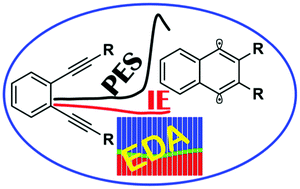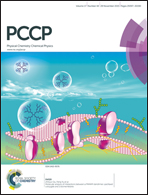Effect of π–π interaction in Bergman cyclisation†
Abstract
The role of π–π interactions in controlling the reactivity and selectivity of a chemical reaction is only recently being explored, even though their ubiquitous role in the structural aspects is well known. We have studied Bergman cyclisation focusing on the effect of π–π interactions on the activation barrier and the variation of π–π interactions along the reaction coordinate. We used enediyne substrates that contain phenyl groups connected to the reaction centres (C1 and C6 atoms), separated by 0, 1 and 2 linker groups. The main difference between the substrates is that the Ph groups enjoy different flexibility to accommodate the changes occurring during the progress of the reaction. The path length of the minimum energy path is increased – shortest in the least flexible substrate (a) and longer in the more flexible ones (c, d and e). We calculated the interaction between the Ph groups, the π–π interaction, using BP86-D3BJ, B3LYP-D3BJ, M06-2X, B2PLYP-D3BJ, SCS-MP2, and SAPT. The BP86-D3BJ was found to be sufficiently accurate with a mean absolute deviation of 0.26 kcal mol−1 with respect to the SAPT2+3 values. The variation in the π–π interaction shows different behaviour in a–e, and this can be correlated with the flexibility of the Ph groups to orient themselves to maintain the optimal relative orientation while conforming to the changes in the reaction coordinate. We analysed the relative orientation of the phenyl groups using certain geometric parameters that showed that when Ph groups can attain a relative orientation close to that of the free dimer, the interaction is maximum. Energy decomposition analysis using SAPT showed that the dispersive interaction is the major contributor (50–60%) to the attractive forces. The π–π interactions influenced the overall activation energy, either by destabilising the substrates or by stabilising the TS – resulting in a variation of about 3.5 kcal mol−1 in activation energies in a–e. The effect of substituents of different electronic nature was assessed which showed that electron donating and electron withdrawing substituents increase the π–π interactions; however, the TS is more stabilised and hence activation energies are increased.



 Please wait while we load your content...
Please wait while we load your content...